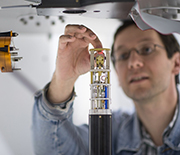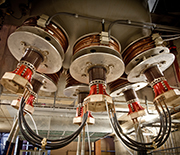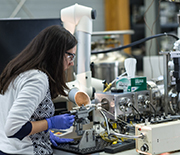News Release 18-020
NSF ‘supermagnet’ laboratory receives $184 million renewal
Record-holding National High Magnetic Field Laboratory is world leader in magnetics research

The NSF-supported National High Magnetic Field Laboratory.
April 2, 2018
This material is available primarily for archival purposes. Telephone numbers or other contact information may be out of date; please see current contact information at media contacts.
The National Science Foundation (NSF) has renewed support for the National High Magnetic Field Laboratory (MagLab) with $184 million over the next five years, a funding increase of more than 9 percent over the last funding period.
Guided by NSF's merit review process, the decision followed approval from the National Science Board in August 2017, and brings the agency's total MagLab investment to $867 million.
The NSF-supported National MagLab meets the needs of scientists by providing access to a range of powerful instruments, including the world's strongest, most continuous high-field magnet, a massive, helium-cooled structure with a strength of 45 Tesla. The lab has also created a magnet that can repeatedly produce a magnetic field of 100 Tesla -- 2 million times stronger than the Earth’s. The magnet is the only one of its kind that can produce fields of that strength without exploding.
Additionally, at 36 Tesla, the MagLab built the most powerful magnet in the world used for nuclear magnetic resonance, a powerful technique biologists, chemists and materials scientists use to study complex structures.
"NSF is proud to support a facility that has broken -- and holds -- many world records in magnet technology," said Anne Kinney, NSF assistant director for Mathematical and Physical Sciences. "But beyond the records, the MagLab enables the world's scientific and engineering community to advance both fundamental science and applied research that benefits society, from next-generation electronics to cutting-edge medicine and energy-efficient systems."
In addition to the primary investment from NSF, the MagLab receives additional financial support from the state of Florida and will remain headquartered at Florida State University. It will retain additional facilities at the University of Florida and, in a continuing cross-agency partnership, at the Department of Energy's Los Alamos National Laboratory.
"This renewal will allow the U.S. to maintain international leadership in critical areas of magnet science and technology, and to break new ground in understanding novel materials for quantum computing and information technology," noted Linda Sapochak, director of the NSF Division of Materials Research.
Each year, more than 1,700 scientists from a broad range of institutions utilize the more than 50 magnets -- including several of the world's most powerful -- at the MagLab's seven user facilities.
"This announcement comes as a strong endorsement for the importance of high magnetic field research in America's science portfolio," said Greg Boebinger, National MagLab director. "The true strength of the MagLab comes from the scientific impact of our users from across the nation, users who access these magnets to make discoveries of new materials, find energy solutions, and explore the science that illuminates life itself."
MagLab research has led to transformative discoveries, from better designs for information storage units in quantum computing known as qubits to improved superconducting materials and new ways to for doctors to classify the severity of strokes using the world's strongest MRI machine, aiding both treatments and diagnoses.
-NSF-
-
A scientist readies a sample to go inside a nuclear magnetic resonance magnet.
Credit and Larger Version -
A 1.43 gigawatt motor generator at the NSF-supported National High Magnetic Field Laboratory.
Credit and Larger Version -
A researcher conducts an experiment using an ion cyclotron resonance magnet.
Credit and Larger Version
Media Contacts
Joshua Chamot, NSF, 703-292-4489, email: jchamot@nsf.gov
Kristin Roberts, National High Magnetic Field Laboratory, (850) 644-1933, email: kroberts@magnet.fsu.edu
Related Websites
The National High Magnetic Field Laboratory Website: https://nationalmaglab.org/
A timeline of milestones at the NSF-supported National High Magnetic Field Laboratory: https://nationalmaglab.org/about/history/timeline
The U.S. National Science Foundation propels the nation forward by advancing fundamental research in all fields of science and engineering. NSF supports research and people by providing facilities, instruments and funding to support their ingenuity and sustain the U.S. as a global leader in research and innovation. With a fiscal year 2023 budget of $9.5 billion, NSF funds reach all 50 states through grants to nearly 2,000 colleges, universities and institutions. Each year, NSF receives more than 40,000 competitive proposals and makes about 11,000 new awards. Those awards include support for cooperative research with industry, Arctic and Antarctic research and operations, and U.S. participation in international scientific efforts.
Connect with us online
NSF website: nsf.gov
NSF News: nsf.gov/news
For News Media: nsf.gov/news/newsroom
Statistics: nsf.gov/statistics/
Awards database: nsf.gov/awardsearch/
Follow us on social
Twitter: twitter.com/NSF
Facebook: facebook.com/US.NSF
Instagram: instagram.com/nsfgov





